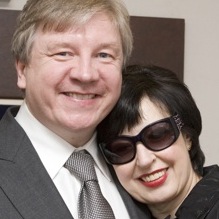 When my wife Anne Holliday died three years ago, she donated her body to Trinity College Medical School.
When my wife Anne Holliday died three years ago, she donated her body to Trinity College Medical School.
This Thursday and next Thursday, RTE is showing a documentary titled A Parting Gift, which follows a year in the life of medical students learning from anatomical donations, including Anne’s, at Trinity College.
Gabrielle Monaghan has previewed the documentary for the Irish Independent. Here is an extract from Gabrielle’s review:
Anne Holliday dedicated her life to helping others. When she was diagnosed with cancer in 2009 and told she had just six months to live, Holliday saw death as another opportunity to do something useful for society. So she signed up to donate her body to Trinity College Dublin’s anatomy department.
Instead of giving friends a funeral she couldn’t attend, Holliday opted for a party, and, shortly after her diagnosis, she married Michael Nugent, her partner of 25 years. Holliday defied medics’ expectations and lived for a year and a half, dying in 2011 at the age of 57.
Holliday was a founder member of New Consensus, a group that campaigned for the revision of the republic’s territorial claim on the North. She organised the first rail journey by the Peace Train between Dublin and Belfast, aimed at challenging the IRA’s disruption of the North-South rail link.
Donating her body was “something we had often talked about in theoretical terms, but it became more real when she was diagnosed with cancer,” said her husband Michael, who is chairman of Atheist Ireland. “We had always been involved in community activities, promoting secularism, and campaigning against terrorism. So this act seemed a natural extension to that. It’s her final project, really.”
Holliday and Nugent feature in A Parting Gift, a new two-part documentary for RTE One about Trinity’s body donation programme. The university’s medical school is one of five in the country that rely on anatomical donations to teach medical, dental and science students.
You can read the full review here:
Life after death? Leaving your body to medical science
You can read the tribute I wrote to Anne shortly after she died here:
My tribute to my late wife Anne Holliday
This brought a tear to my eye. Thanks for sharing.
Lovely photo, by the way.
Thanks for posting about your wife’s wonderful gift.
My husband’s mother died 9 years ago at the age of 62. She had registered as an organ donor but, when registering, could not specify that her body could be used for research and medical training. Unfortunately, because of a high fever when she died, her organs could not be used for transplant. And, because she could not specify that her entire body could be used for research or training, my husband could not donate her body for such purposes.
My husband and I live in a US state which makes it easy to stipulate organ donation, body donation, or both. Donation wishes are part of the Department of Motor Vehicle online records or State ID records, and there is a pink dot imprinted on the driver’s license or State ID card for those who have made donor specifications.
It’s unfortunate that my husband’s mother did not have this simplified method for stating her wishes available to her before she died.
Thanks so much for sharing your wife’s story and for encouraging others to consider a willed body donation to medical science. I teach gross anatomy and neuroanatomy to medical and dental students, and I think nothing can replace cadaver dissection courses during preclinical training. It isn’t just the anatomy education per se: students also learn professionalism, respect, and compassion. Demonstrations of procedures (e.g. airway management, central line placement, anesthetic injection sites) in the anatomy labs help provide clinical relevance to the basic science material, and access to anatomy lab cadavers allows hands-on practice for more advanced students and residents. When students are apprehensive about their first dissection experience, we remind them that the people who leave their bodies to medical science wanted to make a difference in this world, and to contribute to the education of healthcare professionals.
I hope those of us in the US and elsewhere will be able to view the documentary online at some point – I know my anatomy teaching colleagues would also love to see it.
Thank you for the kind comments.
We were also worried about whether Anne’s body would be used, as she and I had been public that she had made preparations to be able to take her own life if she felt she needed to, in order to avoid unnecessary suffering at the end.
Fortunately she did not need to do this, and she died naturally (as do most people who make such preparations), but there was always the possibility that the authorities might seek a post-mortem which would have ruled out donating her body.
It worked out well in the end, if that is not a strange phrase to use about a bereavement, and she was able to fulfil her desire to posthumously continue to be of service to others.
That is so amazing, Michael — bravo to you and to your wife, I hope that her example will be followed by more people.
That was very moving. I don’t know what to say. I’m just sad. I hope this ability we have to be saddened by the pain of others can someday be the foundation for a better world.
I plan on donating my well-used corpse some time in the future. Yep, the f-f-future.
Thank you for writing these really touching tributes, and very interesting with regard to the preparations you and your wife made for her final days. It’s a whole area that I find quite difficult to even think about, and that process is an ongoing challenge for me, so I am always interested to read about the perspectives of others.